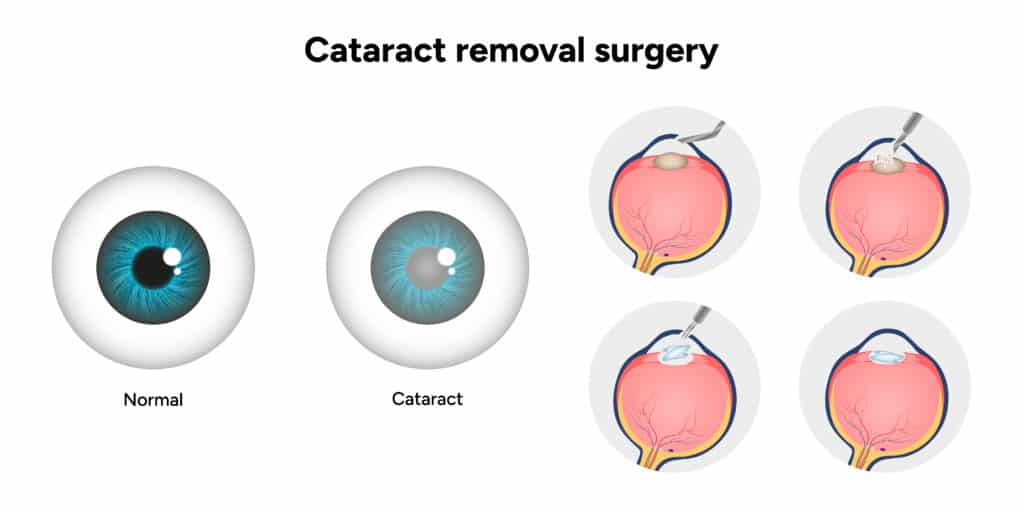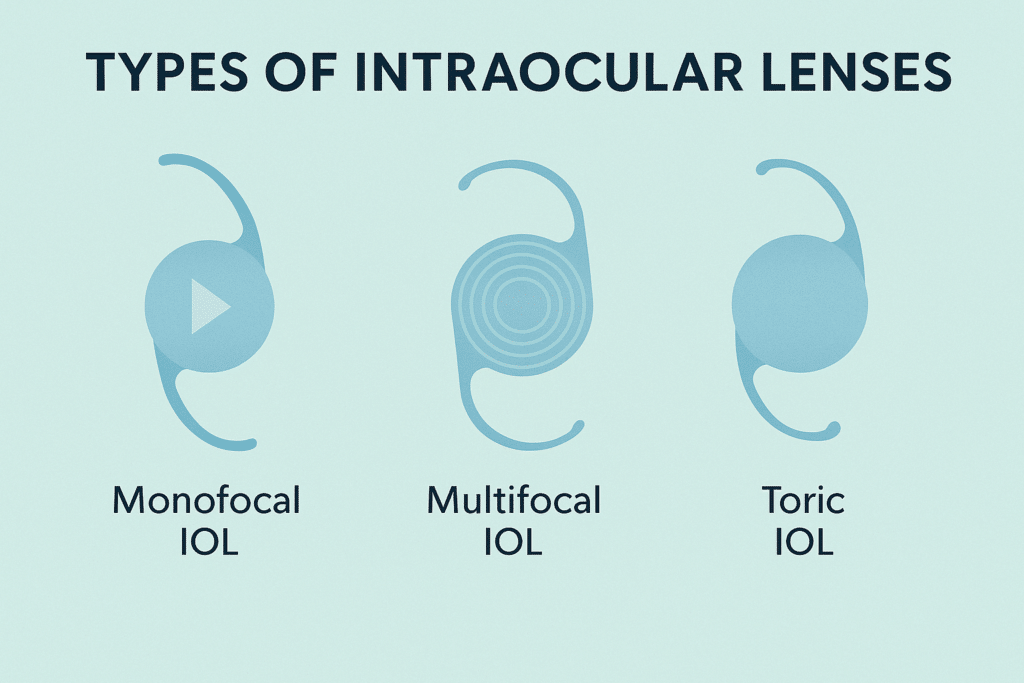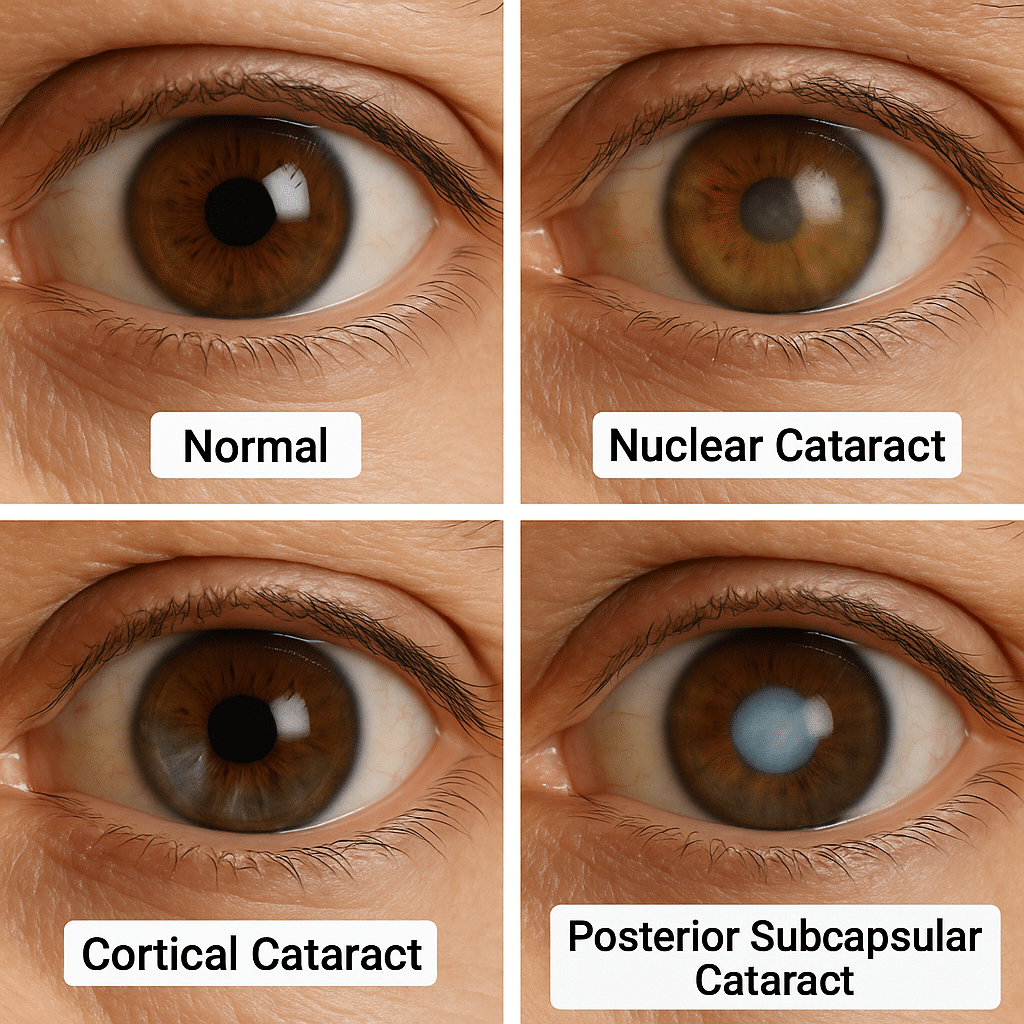Your grandparents might remember long hospital stays for cataract surgery, but today it’s a quick, painless outpatient procedure. Cataract surgery stands as the most common surgical procedure in medicine, with millions of operations performed yearly in the UK and worldwide.
Modern cataract surgery boasts a success rate of over 95%, making it one of the safest and most effective procedures in today’s medical world. The groundbreaking phacoemulsification technique has cut down procedure time to less than 30 minutes, so you can head home the same day. The tiny micro-incisions cause minimal trauma to your eye and speed up healing with fewer complications.
Let’s look at how modern cataract surgery works, what sets it apart from traditional methods, and what to expect before, during, and after the procedure. You’ll soon understand why modern cataract surgery has become the gold standard to treat cataracts the only proven solution for this common eye condition.
What makes modern cataract surgery different
The days of long hospital stays and slow recovery from cataract removal are behind us. Cataract surgery techniques have transformed into a quick, outpatient treatment in the last few decades. The once-scary procedure has become routine. Let’s look at what makes today’s cataract surgery different from older methods.
From large incisions to micro-incisions
The size reduction of surgical cuts marks the biggest breakthrough in cataract surgery. Traditional techniques needed cuts of 12mm. Modern micro-incision cataract surgery (MICS) has brought this down to just 1.8-2mm. This 83% reduction in cut size stands as one of ophthalmology’s greatest achievements.
American ophthalmologist Charles Kelman changed everything in 1967 with phacoemulsification. The old surgery needed large cuts to take out the whole lens nucleus. Instead, phacoemulsification uses an ultrasound-driven needle that breaks up and removes the lens through a tiny opening. Femtosecond laser technology has made these micro-incisions even more precise. The technology creates exact cuts and breaks down cataracts with ultra-short laser pulses. This reduces the need for manual surgical tools. Surgeons can now work with exceptional accuracy during the procedure.
No stitches, faster healing
Patients love that most surgeries no longer need stitches. Today’s micro-incisions seal themselves, which doctors call “stitchless cataract surgery”. Your eye’s internal pressure keeps the cut closed naturally, so there’s no need for sutures.
Stitch-free surgery brings several benefits. Patients now experience:
- Quick healing because there’s less tissue damage
- Less pain and swelling after surgery
- Lower chance of getting infections
- Better vision because of minimal astigmatism
The National Ophthalmic Database found that over 80% of eyes without other problems achieved 6/12 or better vision without correction. Most people see better within days after surgery.
Why it’s no longer a major operation
Cataract surgery has changed from major surgery to a simple outpatient procedure in the last few decades. Recovery used to take three months or more with hospital stays and bed rest. The whole process now takes just a few hours, and surgery lasts only 15-20 minutes. Eye drops numb the surface of your eye instead of general anaesthesia. You stay awake but comfortable during the procedure with minimal discomfort.
You can head home the same day after surgery. Light activities like walking and basic house chores are fine within a week. You can do more demanding activities after two weeks. Full recovery takes about 4-6 weeks. Better surgical methods have made the procedure very safe. Minimal tissue damage reduces complications, and improved fluid systems give better control during surgery. Live measurement technology helps surgeons place lenses perfectly by checking the eye’s focusing power during the procedure.
This shift from major surgery to minor procedure shows modern medicine at its best. Patients now get better results with less intervention, discomfort, and recovery time than ever before.

Understanding phacoemulsification cataract surgery
Modern cataract surgery’s success relies on an amazing technology called phacoemulsification. This technique has changed eye surgery since its introduction. Doctors can now remove cataracts safer, faster, and better than ever before.
What is phacoemulsification?
Phacoemulsification (or ‘phaco’ for short) uses ultrasound energy to break up and remove a cloudy lens through a tiny cut in the eye. American ophthalmologist Dr. Charles Kelman created this innovation in 1967. The idea came from an unexpected place – watching his dentist use ultrasound to clean teeth and remove debris. The name tells you what it does: ‘phaco’ means lens (from Greek ‘phakós’ meaning lentil), and ’emulsification’ describes breaking something into tiny bits. The procedure turns a hard, cloudy lens into fine particles that doctors can easily suction away.
Phacoemulsification has three main parts working together:
- Ultrasound technology to break down the lens
- Aspiration to remove the emulsified fragments
- Irrigation to maintain eye pressure and cool the equipment
Surgeons can now remove cataracts through tiny 2-3mm cuts. This beats traditional methods that needed much bigger openings.
How ultrasound breaks up the cloudy lens
The science behind this procedure is incredible. A handheld ultrasound device with a titanium needle tip vibrates between 27,000 to 60,000 times per second. Most machines today run at about 40,000 Hz – the sweet spot for getting the job done without creating too much heat. The surgeon starts by making a small cut in the cornea and creating an opening in the lens capsule. They then put the ultrasonic probe into the eye. The tip’s fast vibrations deliver just the right amount of energy to turn the hard cataract into liquid. Ultrasonic waves break the molecular bonds that hold the cloudy lens together, and it crumbles into tiny pieces.
The probe works double duty – it breaks up the lens and sucks out the pieces through its vacuum system. A balanced salt solution flows through the eye to keep its shape, pressure, and cool the probe so surrounding tissue stays safe. The outer lens capsule stays intact – this thin membrane that held the natural lens becomes a perfect home for the artificial replacement. A typical procedure takes just 15-30 minutes.

Why it’s the gold standard today
Phacoemulsification stands as the top choice for cataract surgery because it works so well. Most eye surgeons in the UK and other developed countries use this technique. The numbers speak for themselves. About 90% of patients see better after surgery. The World Health Organisation says more than 90% of operations successfully restore useful vision, and at least 80% of eyes achieve good visual outcomes (presenting visual acuity of 6/6 to 6/18).
Small incisions make this procedure special. Most patients don’t need stitches because the wound heals itself. This means faster healing, less inflammation, and fewer complications than older surgical methods. The procedure works well for everyone – young or old, with most types of cataracts. Even people with health conditions can handle it because it’s quick and minimally invasive.
Studies show that phacoemulsification gets better results with fewer risks than older methods like extracapsular cataract extraction (ECCE). ECCE needed bigger cuts and took longer to heal. These proven results have made phacoemulsification the go-to choice for eye surgeons worldwide. This technique has come a long way from its dental tool inspiration to become the life-blood of modern ophthalmology. What used to be major surgery is now a routine procedure that changes people’s lives.
Step-by-step: How modern cataract surgery is done
Modern cataract surgery looks simple but uses sophisticated technology and precision. This outpatient procedure takes between 15-30 minutes to complete. Each step needs careful coordination to ensure the best outcomes. Here’s what happens during this life-changing procedure.
1.Numbing the eye with drops
The surgery starts when the surgeon applies anaesthetic eye drops to your eye’s surface. These drops numb the eye quickly and completely so you won’t feel any pain. Your surgeon might also use:
- Drops to dilate your pupil, which allows better access to the lens
- A mild sedative to help you relax throughout the procedure
Note that you stay awake during the surgery even though your eye becomes completely numb. You can follow your surgeon’s simple instructions, but you won’t see surgical instruments near your eye—just a calming rainbow of lights.
2.Making a tiny incision
The surgeon makes an incredibly small cut in your cornea—the clear front layer of your eye—after complete numbing. This modern technique uses a much smaller incision than older methods, just 2-3 millimetres in size. The incision’s placement and construction are vital to the procedure’s success. This small wound creates a self-sealing tunnel without stitches. Such careful design helps maintain proper eye pressure during surgery and speeds up healing afterward.
3.Removing the cataract
The surgeon reaches the cloudy lens through the tiny incision. A needle-thin ultrasound probe enters the lens where the cataract formed using phacoemulsification.
The probe has two main functions:
- It breaks the cloudy lens into microscopic pieces with ultrasound waves
- It removes these pieces through a vacuum system
A balanced salt solution keeps the eye stable by replacing removed fluid and maintaining proper pressure. This precise fluid management protects your eye’s delicate structures during surgery.
4.Inserting the intraocular lens (IOL)
The surgeon places a clear artificial lens called an intraocular lens (IOL) after removing the cataract completely. Your eye’s precise measurements help select this replacement lens before surgery. This artificial lens can fold to fit through the same tiny incision. It unfolds naturally inside your eye and sits within the empty lens capsule—a thin membrane that held your natural lens. The IOL becomes a permanent part of your eye without needing maintenance or replacement.
5.Letting the eye heal naturally
Your surgeon might place a protective shield over your eye when finished. The eye’s natural pressure seals the incision without stitches in most cases. Recovery happens much faster than with traditional cataract surgery. Most patients see better within days after surgery, though full stability takes several weeks. The self-sealing incision helps speed up recovery time and reduces complication risks. This advanced technique stands out as one of the biggest breakthroughs in modern cataract surgery. Patients can return to their normal activities and see clearly sooner than ever before.

Types of intraocular lenses and what they do
Your visual outcomes after cataract surgery depend a lot on picking the right intraocular lens. Today’s lens technology gives you several choices that target specific vision needs.
Monofocal lenses: standard option
Monofocal lenses top the list as the most popular IOL type. They come with a single focusing power that makes either your distance, intermediate, or close-up vision sharper. Most people set these lenses for distance vision to see things like driving more clearly.
You’ll probably need reading glasses for close-up tasks with standard monofocal lenses. In spite of that, they have some great benefits:
- Crystal clear vision at their set focal point
- Time-tested results with proven outcomes
- Better sight in dim lighting
- Affordable option that insurance usually covers
To name just one example, see how monofocal lenses work with “monovision” – one eye focuses on distant objects while the other handles close-up vision. This setup lets your eyes team up to see objects at different distances.
Multifocal lenses: for near and far vision
Multifocal lenses pack several focal zones that let your brain pick the right focusing power for each task. These premium lenses outperform monofocal options by improving both your close-up and distance vision. Many people don’t need glasses anymore after getting them. The numbers tell the story – 95% of patients don’t reach for their glasses during daily activities after getting multifocal implants. These lenses are a great way to get visual flexibility across distances without switching glasses all the time.
Light rings or halos might show up around lights with these lenses, especially during night driving. About 5-10% of people notice these effects, but most adjust within 2-3 months after their surgery.
Toric lenses: correcting astigmatism
Toric lenses offer a targeted solution if you have astigmatism where your cornea has an irregular shape. These specialised lenses have different powers along various meridians to fix your cornea’s uneven curve. The lens compensates for your exact degree and axis of astigmatism. You can pair them with monofocal, multifocal, or extended depth of focus models. They boost vision quality by cutting down glare and halos that people with astigmatism often see.
The benefits stand out:
- Fixes cataracts and astigmatism in one procedure
- Sharper distance vision compared to basic lenses
- Less need for prescription glasses
Choosing the right lens for your lifestyle
Your daily activities and vision needs should guide your lens choice. Think over what visual tasks matter most in your life. The big questions: How often do you drive? Do you love reading? How much computer work do you do? Your job might push you toward one option over another. Someone who works with tiny details needs different lenses than someone who mostly looks at things far away. Your favourite activities matter too—whether you spend time outdoors, make crafts, or hang out with friends. Money matters since premium options like multifocal and toric lenses cost more than what insurance covers. The best choice balances your vision goals, lifestyle, and budget. Your surgeon will check your eyes thoroughly and talk about your vision expectations and daily routine to help find your perfect lens match.
What to expect after surgery
Your cataract procedure recovery is much simpler than older surgeries. A good understanding of the process will help you prepare better for the coming weeks.

Quick recovery timeline
Eye drops used to dilate your pupils cause some blurriness for a few hours after surgery. Your vision should improve noticeably the next day. You might feel mild discomfort, notice redness, watering, or a gritty feeling in your eye. These issues usually go away within days. Modern cataract surgery patients recover fully in 2-6 weeks, though recovery time varies among patients. Patients with simple surgeries see their vision stabilise quickly. The Sunderland Cataract Study showed vision function improved shortly after surgery.
Post-op care and eye drops
Eye drops play a vital part in your recovery. They prevent infection and reduce inflammation. You’ll need:
- Antibiotic eye drops for about a week
- Anti-inflammatory eye drops for 3-6 weeks
- Lubricating drops as needed for dryness
Wraparound sunglasses protect your eyes from dust, dirt, and bright light. Your surgeon might suggest wearing an eye shield at night during your original recovery. Modern cataract surgery differs greatly from older methods. We use advanced technology and expert surgical care at Precision Vision London to restore your vision safely.
When to resume normal activities
Normal daily activities can resume after 1-2 weeks post-surgery. Here’s what you should know:
- Skip strenuous exercise and heavy lifting for at least a week
- Stay out of swimming pools for 4-6 weeks
- Start driving once your vision meets DVLA requirements
- Return to office work within days
How cataract surgery improves quality of living
Modern cataract surgery benefits go way beyond better vision. Studies show vision improvement boosts health-related quality of life. Research confirms better cognitive, emotional, and general wellbeing after first and second eye surgeries. Patients who have both eyes treated see much greater improvement in their vision-related quality of life compared to single eye surgery. Better vision leads to more independence, confidence in moving around, and renewed interest in old hobbies.
Is cataract surgery safe? Success rates and risks
Cataract surgery ranks among the safest surgical procedures today. Patient outcomes keep getting better each year.

What is the average success rate of modern cataract surgery?
Modern cataract surgery delivers impressive results. More than 95% of patients see better after their procedure. The success rate in UK practises reaches 98%. The National Ophthalmology Database shows that vision significantly decreases in only 1 out of 200 patients after surgery.
Common side effects and how they’re managed
Patients usually experience mild and temporary effects:
- Blurry vision during the first few days
- Mild discomfort or gritty feeling
- Dry eyes that need lubricating drops
- Sensitivity to light that sunglasses help reduce
These effects go away within days or weeks. Your surgeon will give you anti-inflammatory drops to reduce swelling.
Why complications are rare with expert care
Serious complications rarely occur now. The UK’s posterior capsule rupture rate—a key quality indicator—has dropped to 0.87%, which is less than half compared to a decade ago. The risk of severe vision loss affects about 1 in 500 patients.
At Precision Vision London, we combine advanced technology with expert surgical care to restore your vision safely. Book your cataract consultation today & experience the modern difference.
Conclusion
Cataract surgery stands as one of medicine’s greatest achievements. The procedure has evolved from requiring lengthy hospital stays to becoming a quick, painless outpatient treatment. Surgeons now use the revolutionary phacoemulsification technique with tiny micro-incisions that takes less than 30 minutes and eliminates stitches in most cases.
The benefits go well beyond better vision. Your surgeon can tailor the procedure to your lifestyle with various intraocular lens options. These options help with distance vision, reading, or reduced dependence on glasses. The quick recovery lets patients return to normal activities within days instead of weeks. Modern cataract surgery’s success rates exceed 95% in the UK, with minimal risk of complications. This impressive safety record comes from continuous advances in technology combined with skilled surgeons’ expertise.
Clear vision no longer requires major surgery or long recovery times. Cataracts remain the leading cause of reversible blindness worldwide, but treatment is now more available and effective than ever. Precision Vision London’s expert surgeons combine advanced technology with personalised care to restore your vision safely. Book your cataract consultation today to see the difference.
FAQs
Q1. How long does modern cataract surgery typically take? Modern cataract surgery is remarkably quick, usually taking between 15 to 30 minutes to complete. However, you should plan to spend about 2-3 hours at the clinic for preparation and initial recovery.
Q2. Is cataract surgery painful? No, modern cataract surgery is virtually painless. The procedure uses topical anaesthetic eye drops to numb the surface of your eye, ensuring you feel no discomfort during the surgery. You remain awake but relaxed throughout.
Q3. What is the recovery time after cataract surgery? Most people notice significant improvement in their vision within a few days after surgery. However, full recovery typically takes 2-6 weeks. During this time, you’ll use prescribed eye drops and gradually return to normal activities as advised by your surgeon.
Q4. What are the success rates of modern cataract surgery? Modern cataract surgery has exceptionally high success rates, with over 95% of patients experiencing improved vision following the procedure. In many UK practises, this figure approaches 98%, making it one of the safest and most effective surgical procedures available.
Q5. What types of intraocular lenses (IOLs) are available for cataract surgery? There are several types of IOLs available, each designed for specific vision needs. These include monofocal lenses (set for one focusing distance), multifocal lenses (for both near and far vision), and toric lenses (to correct astigmatism). Your surgeon will help you choose the best option based on your lifestyle and visual requirements.
Authors & Reviewer
-
 Olivia: Author
Olivia: AuthorHi, I'm Olivia, a passionate writer specialising in eye care, vision health, and the latest advancements in optometry. I strive to craft informative and engaging articles that help readers make informed decisions about their eye health. With a keen eye for detail and a commitment to delivering accurate, research-backed content, I aim to educate and inspire through every piece I write.
-
 Dr. CT Pillai: Reviewer
Dr. CT Pillai: ReviewerDr. CT Pillai is a globally recognised ophthalmologist with over 30 years of experience, specialising in refractive surgery and general ophthalmology. Renowned for performing over 50,000 successful laser procedures.

